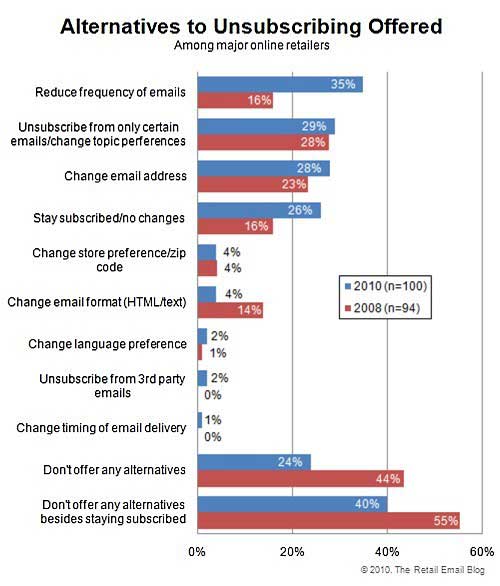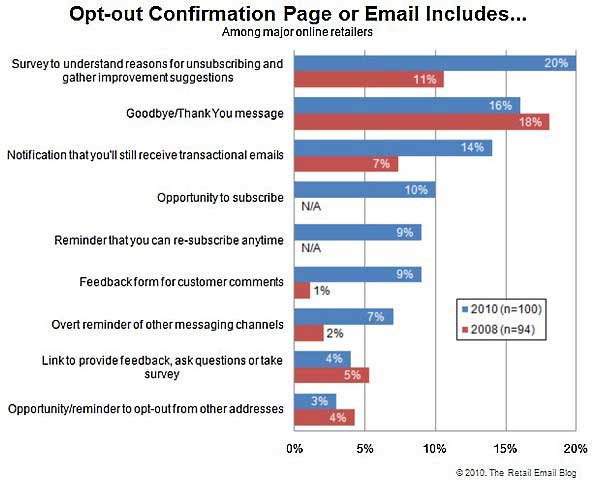Many retail email marketers have learned that their best defense against subscribers' clicking the "report spam" button is to provide not only a friction-free process to enable unsubscribing but also options that ISPs can't give email recipients, according to a study by Smith-Harmon.
Overall, most consumers opt out of permission email because of the lack of relevance and high frequency levels, though they also unsubscribe because they want to re-subscribe with a different email address; accordingly, presenting multiple email management options in every email can be an effective tactic for reducing unsubscribes, according to Smith-Harmon.
More than one-third (37%) of major online retailers provide a link to change or manage preferences and 22% provide a change email address link.

Looking to capitalize on email forwarding, 18% of retailers also include a subscribe link, often with a message such as "Did a friend forward this email to you? Sign up to get your own."
Below, other findings from the 2010 Retail Email Unsubscribe Benchmark Study by Smith-Harmon.
In addition to unsubscribe links, 17% of major online retailers offer at least one other way to opt out of email communications: 13% suggest subscribers reply to or forward emails to a certain address, 4% suggest a call to customer service, and 3% suggest a mailed letter to the company.
The Opt-out Process
Over the past two years, there has been a significant shift toward longer unsubscribe processes that in some cases present more choices to subscribers.
Since 2008, the average number of clicks necessary to opt out has increased 18%, to 2.4.
Over one-third (39%) of major online retailers now require three or more clicks to opt out of emails, up from 7% in 2008, and more than the ideal two-click maximum, according to Smith-Harmon.

At the other end of the spectrum, only 3% of retailers use a one-click unsubscribe process, down from 9% who did so a year earlier.
In addition, 15% of retailers require subscribers to enter their email at least once, unnecessarily introducing more friction to the process, according to Smith-Harmon.
The Opt-down Option
Marketers are giving subscribers more control over frequency: 35% of retailers now allow subscribers to reduce the frequency of the emails they receive, versus opting out altogether—up from the 16% of retailers who did so a year earlier.
That increase is likely driven by two factors: the continued rise in retail email volume, which increased 12% year over year,* and an ever broadening definition of "spam" in the minds of consumers, which now includes emails they have signed up for but no longer want.

Among other unsubscribing alternatives, 29% of major online retailers allow subscribers to opt out from certain messages or to change their topic preferences, while 28% allow them to change their email addresses.
Looking for solid, substantiated information about email from the industry's best resources? The 67-page Email Marketing Factbook featuring 39 charts tells you about email usage, what captures users' attention, and how organizations are using email to reach customers. This email factbook consists of chapters 1 & 2 from the larger Digital Marketing Factbook a 144-page compilation of data and 110 charts that also covers search engine marketing and social media.
Opt-out Confirmations
Many marketers are indifferent toward subscribers who opt out: Only 16% of retailers say "Goodbye" or "Thank you" to departing subscribers, down from 18% in 2008. However, 20% now send surveys to better understand why consumers opted out, up from 11% who did so a year earlier.

Just 7% offer reminders of other messaging channels, such as RSS (5%) and Facebook pages (2%), even though more than 30% of them include such links in their emails.
Other findings:
- 30% of retailers send one or more emails following an unsubscribe request, up from 26% in 2008.
- Due to failures to honor opt outs, 4% of retailers are not in compliance with the CAN-SPAM Act, on par with 2008 levels.
* According to the Smith-Harmon Retail Email Year-End Trends for 2009 report.
About the data: Findings are based on data collected from November 2009 to January 2010 among unsubscribing consumers from email marketing programs of 100 major US online retailers tracked by the Retail Email Blog, published by Smith-Harmon, a Responsys Company.



